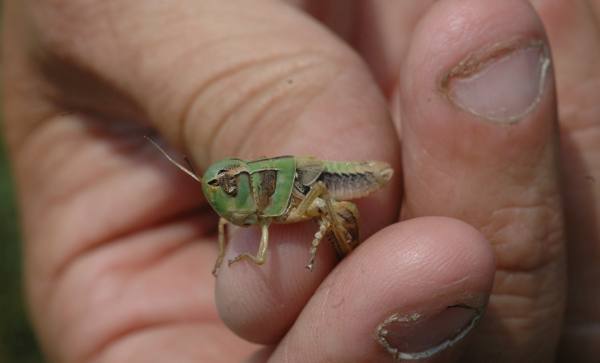
Drought still affecting this year’s grasshopper and honeybee populations
Texas hosts about 150 grasshopper species, according to Texas AgriLife Extension Service entomologists.The grasshopper hatch came early this year because of the relatively warm spring, Sansone said.The best way to control grasshoppers is to spray when the hatches first start, when control is very inexpensive.
June 12, 2012

Last year’s drought is the most likely reason producers are seeing more grasshoppers and fewer honeybees this year, according to a Texas AgriLife Extension Service expert.
High grasshopper populations are tied to hot, dry weather for a number of reasons, said Dr. Chris Sansone, associate department head and AgriLife Extension program leader for entomology, San Angelo.
“The drought damaged range and pasture grasses, creating areas with no to little grass,” Sansone explained. “Hatching grasshoppers use these areas to warm up in the spring. The open areas also slow the insect fungus that normally controls grasshoppers. The fungus is one of the main threats to small grasshoppers, and the open areas dry out quicker, which limits the fungus, with the result of a larger proportion of eggs surviving.”
But grasshoppers, being cold-blooded, also thrive with warmer temperatures, he said. Hot weather means their metabolisms run faster, so they eat more and grow faster.
On top of these factors, the grasshopper hatch came early this year because of the relatively warm spring, Sansone said.
The best way to control grasshoppers is to spray when the hatches first start, when control is very inexpensive.
“Insecticides like Dimilin prevent the insects from molting,” Sansone said. “The product must be sprayed when the grasshoppers are young, before they form wings.”
But even in a normal year, “what usually happens is that people aren’t paying attention to development, and by June and July we have large grasshopper numbers leaving their habitat in search of food, resulting in a constant invasion, and we have to spray every seven to 10 days,” he said.
And it was easier to get behind this year as the hatch came a couple of weeks early in many areas due to unseasonably warm weather, Sansone added.
“Normally, we need to treat in mid-April, but this year we needed to treat in mid-March to the first of April,” he said.
But grasshopper issues, though horrendous in some areas, still vary throughout the state.
“The state is big enough, and the conditions are different enough that infestations are not very consistent,” Sansone said. “So we have traditional hot spots such as Central Texas and around the Stephenville area. But in South Texas we very rarely hear about grasshopper outbreaks, and I haven’t heard of any in the Weslaco or the Corpus Christi regions right now.”
There have also been regional reports of poor honeybee honey-production and low brood numbers despite many areas having good flower blooms. Sansone said this too is most likely a result of the drought.
“There was a large decline in hive strength because of that drought, in my opinion,” Sansone said. “I don’t think the numbers were high coming into 2012, and I think that is what the beekeepers are experiencing. We had good flower production, so you would have thought that nectar production would have been good, but the bee numbers just weren’t there.”
We see our highest bee numbers when there is average or above-average moisture, he said.
More information on the current Texas drought and wildfire alerts can be found on the AgriLife Extension Agricultural Drought Task Force website at http://agrilife.tamu.edu/drought/.
You May Also Like



